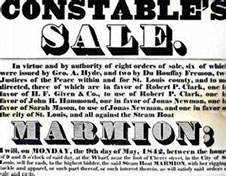




Executions and Garnishments
Executions
If a judgment isn't paid, there are two actions every creditor should take in establishing and protecting that judgment. The first is abstracting that judgment in the real property records of the county where the judgment was issued (and any other counties where one may think the debtor has non-exempt property). The second is to get a writ of execution executed by the clerk and processed by the constable.
The reason to always get a writ of execution issued is that judgments only last ten years unless a writ of execution is issued on them. Texas Civil Practice & Remedies Code § 34.001. Every time a writ of execution is timely issued, the life of the judgment is extended an additional ten years from the date of the writ.
When a writ is issued, the constable will take the writ and contact the debtor. He will ask the debtor if he has non-exempt assets that may be sold at auction to satisfy the judgment. The debtor may deny having any non-exempt assets and often will. Unless, the constable has advanced instructions of non-exempt property or non-exempt property is in plain sight (i.e. significant business assets), the constable will not look further. The constable will return the writ of execution marked 'nullo bono', meaning nothing was found.
It is for this reason that is generally best practice to conduct some post-judgment discovery prior to issuing a writ of execution.
If the constable does take possession of non-exempt property, it will be sold at public sale much like the first-Tuesday-of-the-month foreclosure sales. (If the property seized and sold is real property, it is sold in the same manner as a foreclosure sale, although technically it is still a constable sale).
The constable will take proceeds from the sale, add in all adjudged costs and distribute all proceeds necessary to the creditor until the judgment is satisfied. (If not satisfied, the judgment remains open with the amount paid thus far credited against the judgment in the Court's records.)
As with garnishments below, attorney's fees incurred, although minimal, are generally not recoverable in this procedure. However, they may be added later in an application for turnover/receivership.
Garnishments - (Freezing Accounts)
Garnishments have appeal as being a quick surprise action that often gets the debtor to the settlement table while the bank accounts are locked up for the 21 days after the garnishee (the party holding the debtor's funds) receives the writ.
There are disadvantages though.
- The garnishor cannot recover attorney's fees; Texas Civil Practice and Remedies Code 677. General Electric Capital Corp. v. ICO, Inc.; 230 S.W.3d 702, 710 (Tex.App.--Houston [14th Dist.] 2007 pet. denied).
- The garnishee (i.e. the holding bank) always recovers attorney's fees. If there are enough funds from the debtor's account, they are paid from there. If not, the creditor gets to pay the attorney's fees. If there was no debtor bank account or the balance was zero - the creditor still gets to pay the banks fees.
- Absent actually having a previously written check from the debtor, or having post-judgment discovery on the debtor's bank accounts, it is very hard to identify the debtor's accounts. (JH&A has sources, but they are expensive. Many judgments are not large enough to justify this sort of investigative activity - as again, the investigation fees, like attorney's fees, are not recoverable in a garnishment.)
Generally, the best practice is to pursue a turnover/receivership, where such fees are recoverable. Of course, that and post-judgment discovery are with notice to the debtor, who may then further move and conceal funds. If there is a concern that debtor will move and hide funds, an initial well aimed garnishment attempt prior to pursuing other remedies can be tactically legitimate.

281-408-3683




© 2015, 2022